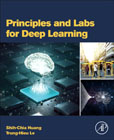
In recent years, Deep Learning has been applied successfully for diverse fields such as computer vision, audio processing, robotics, natural language processing, bioinformatics and chemistry. Because of the huge scope of knowledge in Deep Learning, it requires a lot of time to understand and deploy useful, working applications. Principles and Labs for Deep Learning helps the reader start using Deep Learning on their scientific research project, product, or platform in practical and applied manner. Both theory lessons and experiments are included in each chapter to introduce the techniques and provide source code examples to practice using them. Each chapter has one corresponding Lab with step-by-step instruction to help the reader practice and accomplish a specific learning outcome. All Labs for this book are placed on GitHub to facilitate the download. The book is written based on the assumption that the reader knows basic Python for programming and basic Machine Learning. Principles and Labs for Deep Learning is the first book to provide the knowledge and techniques to help the reader start designing and developing Deep Learning models on their project or platform. Each Deep Learning technique is introduced through the theory, illustrated and explained through the TensorFolow source code examples, and analyzed through the visualization of results. This helps readers to rapidly understand and apply each technique. The structured methods and labs provided by Dr. Huang and Dr. Le will enable readers to become proficient in using TensorFlow to build deep Convolutional Neural Networks (CNNs) through custom APIs, high-level Keras APIs, Keras Applications, and TensorFlow Hub. Readers will develop proficiency in using TensorBorad to visualize the model graph, view and track metrics such as loss and accuracy, histograms of weights, and image results as they change over time during training deep CNNs. Readers will be able to confidently implement, tune, evaluate, and make predictions with deep CNNs for regression problems, binary classification problems, and multi-category classification problems, and will understand how to use techniques such as training methods, transfer learning, and data augmentation techniques for improving the performance of deep neural networks development. By the end of the book, readers will also understand how to use TensorBoard HParams to analyze multiple training models for choosing the best factors of the designed model such as the number of layers, which type of Optimizer, and so on. Introduces readers to the usefulness of neural networks and Deep Learning methodsProvides readers with in-depth understanding of the architecture and operation of Deep Convolutional Neural NetworksDemonstrates the visualization needed for designing neural networksProvides readers with in-depth understanding of regression problems, binary classification problems, multi-category classification problems, Variational Auto-Encoder, Generative Adversarial Network, and Object detection INDICE: 1. Introduction to TensorFlow2.0 2. Regression Problem 3. Binary classification problem 4. Multi-category Classification Problem 5. Training Neural Network 6. Advanced TensorFlow2.0 7. Advanced TensorBoard 8. Convolutional Neural Network Architectures 9. Transfer Learning 10. Variational Auto-Encoder 11. WGAN-GP 12. Object Detection
- ISBN: 978-0-323-90198-7
- Editorial: Academic Press
- Encuadernacion: Rústica
- Páginas: 332
- Fecha Publicación: 01/07/2021
- Nº Volúmenes: 1
- Idioma: Inglés
